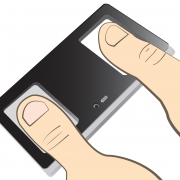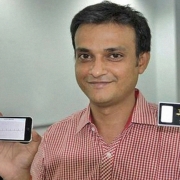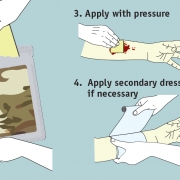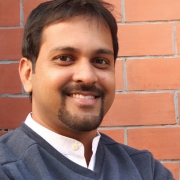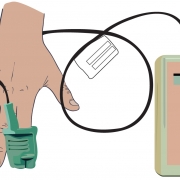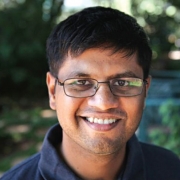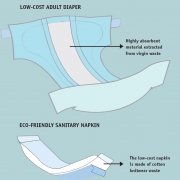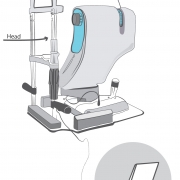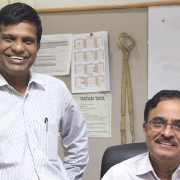
People

The word innovation is often confused with space-age gizmos and gadgets, nanoparticles and robotics, the terribly complex and cutting edge. However, it is actually much more simple and succinct: innovation pivots upon the power of an idea.
For a country like India, which is expected to replace China as the most populous country in the world by 2022, the need of the hour is innovation that enables access to mechanisms of delivery—in finance, education and, most significant, healthcare—bridging the gaps of demography and geography.
In a bid to fuel such solutions and raise awareness on the need for sustainable, affordable innovation that addresses the requirements of the resource-poor in the real India, eminent scientist Padma Vibhushan Dr Raghunath Mashelkar introduced the ‘Anjani Mashelkar Inclusive Innovation Award’ in 2011. The award recognises innovators for their game-changing and life-affirming ideas and spurs further home-grown creative thought that empowers and enriches the lives of Indians. (The award winners get a prize cash of ₹ 1.1 million each).
Rachna Virdi interacts with some winners of the award to gain insight into their innovations—and their belief in not just best practices but next practices.
This year’s Anjani Mashelkar Inclusive Innovation Award ceremony is being held on 17 November
ANJALI MASHELKAR INCLUSIVE INNOVATION AWARD WINNER 2015
RAHUL RASTOGI AGASTA
SOFTWARE PVT LTD FOR SA NKET ECG DEVICE
The product: Sanket ECG Device is a hi-tech innovative solution for personal cardiac care. This pocket-sized heart rate device is the fastest, most affordable and accurate monitor for cardiovascular diseases and stress management.
The catalyst: Stress and cardiovascular diseases are global killers, with about 4 crore people across the world dying every year because they fail to reach the hospital on time. A majority of Indians live in rural areas, away from hospitals. Thus, a device that affordably, accurately and speedily monitors the heart health of Indians is the need of the hour. This realisation—and his own father’s heart condition that couldn’t be operated upon owing to diabetes—prompted Rahul Rastogi and his wife Neha to develop a prototype device that could detect heart trouble. This led to the birth of the Sanket ECG device.
How it works: The 12-lead ECG recorder is a quick screening and analytic tool that connects to a smartphone wirelessly. Just place both thumbs on the glass slots and wait for the readings; within a few minutes, it displays and records the ECG graphs. The ECG report can be shared easily with a doctor via email or Bluetooth. As it is user-friendly, Sanket can be used to monitor heart health on a daily basis.
USP: The device marks a dramatic shift in the way we approach cardiac care, doing away with expensive ECG machines, distant hospitals or laboratories, and skilled technicians. Being affordable, it has been mass-adopted in rural set-ups. The company is working closely with tech giants and will soon have a simultaneous data processing capability of 1 million. What’s more, the analytics will be able to predict heart and overall health in a mere 15 seconds of use.
Cost and availability: While a conventional ECG machine costs ₹ 40,000 to ₹ 200,000, the Sanket ECG monitor costs just ₹ 9,999 and is available on Amazon; Android and iPhone apps are also available free of cost. For more details, visit www.agatsa.com
DID YOU KNOW?
- ECG (electrocardiography) is a non-invasive procedure to monitor heart activity.
- It is performed on a patient with symptoms like pain or discomfort in the chest, palpitations, abdominal pain, nausea and weakness.
- ECG displays the readings in the form of signals that are understood by specialists.
- The electrical impulses determine your heart’s rhythm.
- ECG doesn’t send any electricity through your body; it merely measures the electricity in your heart.
- An ECG test is not painful.
ANJALI MASHELKAR INCLUSIVE INNOVATION AWARD WINNER 2013
LEO MAVLEY
AXIO BIOSOLUTIONS FOR AXIOSTAT
The product: Axiostat is a sterile, non-absorbable haemostatic dressing for wound in trauma care for temporary control of bleeding wounds. This clinically validated product can help save the lives during emergencies such as accidents and disasters. It is also useful for people with bleeding disorders and those who use blood thinners— many silvers are on blood-thinning medications, for whom profuse and unstoppable bleeding can be life-threatening.
The catalyst: According to inclusive innovator Leo Mavley, globally almost 10 people die every minute from traumatic injuries or violence. In many cases, traumatic life-threatening bleeding is the cause of death. Unfortunately, trauma care, which is essential to improve chances of survival and prevent lifelong disabilities in victims, is not easily accessible to all. In fact, according to a report by WHO, injury is expected to be the third leading cause of death in India by 2020. Having taken bleeding patients to hospitals, Mavley realised the need for a product that stems trauma-related bleeding.
How it works: Axiostat utilises a unique patented manufacturing process that can control severe haemorrhage within minutes. It uses ‘chitosan’, a natural biomaterial extracted from shellfish that is highly purified and processed. The technology works on the principle of adhesion owing to charge. It is designed to be positively charged; blood cells carry a net negative charge. You just need to place the dressing on the wound and apply uniform pressure for two minutes. When the blood comes in contact with Axiostat, oppositely charged components attract and form bonds. This results in a strong adhesive seal that acts as a mechanical barrier preventing blood from leaking out.
USP: Axio Biosolutions is the first company in India to design, develop and commercialise an emergency haemostat for trauma care that is effective and affordable. For details, visit www.axiobio.com
DID YOU KNOW?
- Haemostatic agents are used during surgical procedures to achieve haemostasis, or clotting of the blood.
- They vary on the basis of their action, composition, ease of application, adherence to tissue and cost.
- Categories of haemostatic dressings include haemostats, sealants and adhesives.
ANJALI MASHELKAR INCLUSIVE INNOVATION AWARD WINNER 2012
MYSHKIN INGAWALE
BIOSENSE TECHNOLOGIES FOR TOUCHB
The product: ToucHb is a needle-free anaemia screening technique. It is a low-cost, portable, systemic healthcare solution with the potential to help millions in developing countries.
The catalyst: Undiagnosed and untreated anaemia can often be life-threatening. Anaemia, or abnormally low haemoglobin in the blood, affects more than half the children under five years of age all over the world and is also the biggest cause of maternal mortality in the developing countries. According to a study, 136,000 women die during childbirth every year because of complications at birth, most of which are associated with undetected anaemia which is often left untreated. Innovator Myshkin Ingawale developed ToucHb from the conviction that these deaths were completely preventable.
How it works: ToucHb comes with a probe into which the finger is inserted. The probe is embedded with tiny diodes that send a signal to an iPad-sized device, which measures the haemoglobin levels in the blood.
USP: ToucHb is simple, inexpensive and non-invasive and requires no needles, hi-tech gadgets or trained assistants, making it ideal for rural areas. Ease of use, speed of diagnosis and affordability without compromise on quality make this device outstanding. For details, visit www.biosense.in
FAST FACTS
- Anaemia develops when the blood lacks enough healthy red blood cells or haemoglobin.
- Certain forms of anaemia are hereditary and infants may be affected from the time of birth.
- A person with anaemia feels tired, breathless and experiences low energy, heart palpitations and symptoms of fainting.
- Women in the childbearing age are susceptible to anaemia owing to loss of blood from menstruation.
- Older adults are prone to low haemoglobin levels owing to a poor diet and other health conditions.
ANJALI MASHELKAR INCLUSIVE INNOVATION AWARD WINNER 2011
DR BHAWANA CHANANA
DIRECTOR-PROFESSOR AMITY UNIVERSITY FOR LOW-COST HYGIENE PRODUCTS
The product: Inclusive innovator Dr Bhawana Chanana’s low-cost diaper for adult incontinence is a path-breaking innovation to improve the hygiene in poor elders. It uses indigenously available raw material (extracted from virgin waste like cotton knitwear fabric waste and agro-residues like bagasse from sugarcane fibres) to recycle, upcycle and process low-cost adult diapers. Dr Chanana’s other innovation is Suvidha, a low-cost brand of quality sanitary napkins made of cotton knitwear.
The catalyst: After completing her PhD in fabric and apparel science from Delhi University’s Department of Home Science, Dr Chanana worked with the Government’s Department of Science and Technology (DST) and helped set up units and machines in the rural and peri-urban areas. Having worked closely with silvers and during her visits to hospitals and old-age homes, she realised urinary incontinence is a real concern that often goes neglected. With the cost of a normal adult diaper as prohibitively expensive as ₹ 45 to ₹ 80 per unit, elders, especially in old-age homes, are left suffering. Also, her work with women led her to realise the crying need for low-cost sanitary napkins to promote better personal hygiene.
How it works: These diapers significantly reduce skin irritation that normally leads to the formation of bedsores and reduce the risk of mishaps owing to involuntary leakage of urine from the bladder in silvers. And the sanitary napkins made of knitwear waste are eco-friendly, highly absorbent and safe to use.
USP: Owing to the indigenous design and the engagement of NGOs and self-help groups to produce and market these products, they are affordable and accessible, without compromising on quality. Both products stand their ground against more expensive products in the market—the diapers measure up in terms of looks, length, girth and thickness to suit the user, while a three-cycle assessment of the napkins received a positive response from women.
Cost and availability: The diapers cost ₹ 15 to ₹ 18 per unit (up to one-fourth the cost of commercially available diapers) while the sanitary napkin is available at ₹ 1 per unit. Both products are available all over India. To learn more, contact bhawanachanana@gmail.com
WHAT TO LOOK FOR IN AN ADULT DIAPER
- The diaper should hug your body correctly.
- It should be comfortable to wear.
- It should be highly absorbent to soak in the moisture and prevent sores or rashes.
- It should protect from odours.
- It should give you complete coverage and protection.
ANJALI MASHELKAR INCLUSIVE INNOVATION AWARD WINNER 2011
DR SHYAM VASUDEV & K CHANDRASHEKHAR
FORUS HEALTH FOR 3NETHRA
The product: 3nethra is a portable non-invasive, non-mydriatic (without dilating the pupil), low-cost imaging device that helps pre-screen five major eye diseases—cataract, diabetic retinopathy, glaucoma, cornea and refractive error—with its inbuilt, auto-detection software. It is available in three types, Classic, Royal and Flora; besides which there is 3nethra Neo for neonatal screening; 3nethra Kiddo for refraction for kids; and 3nethra Specto, the world’s first wearable phoropter (ophthalmic testing device/refractor).
The catalyst: India has 15 million people suffering from blindness; 80 per cent of these cases could have been prevented with timely screening. While working at the Philips Innovation Campus (the Bangalore-based R&D unit of Netherlands-based Philips), Dr Shyam Vasudev and K Chandrashekhar, inspired by Aravind Eye Care, aimed to develop an affordable, technology-based solution for early detection of eye diseases. They worked further to develop such a device at the Indian Institute of Science and created 3nethra.
How it works: 3nethra has a retinal camera with an inbuilt refractometer. It captures images of the retina and generates an automatic report about the problem within five minutes of screening.
USP: Affordable, profitable and sustainable, 3nethra enables those at risk of losing their eyesight to detect the problem early and start treatment. It can be operated by a minimally trained operator and presents a value proposition for everyone in the eye-care chain, from silvers to doctors, eye hospitals, rural entrepreneurs and pharmaceutical companies.
Cost and availability: 3nethra costs just one-sixth of the price of collective pre-screening devices at ₹ 500,000, compared to other devices that range between ₹ 500,000 and ₹ 1.8 million. Manufactured in Bengaluru, it is available all over the world—to date, there have been 1,200 installations in 25 countries and has touched the lives of 2 million people. For more details, visit www.forushealth.com
OTHER TYPES OF EYE IMAGING
- Optical coherence tomography
- Colour fundus photography
- Fluorescein angiography
- Indocyanine green angiography
- Fundus autofluorescence
- Corneal topography
- Slit-lamp photography
- External photography
- Optic nerve head analysis
- Endothelial cell-layer photography
Illustrations by: Sanjhi Shah Photograph by iStock Featured in Harmony — Celebrate Age Magazine October 2016
you may also like to read
-
For the love of Sanskrit
During her 60s, if you had told Sushila A that she would be securing a doctorate in Sanskrit in the….
-
Style sensation
Meet Instagram star Moon Lin Cocking a snook at ageism, this nonagenarian Taiwanese woman is slaying street fashion like….
-
Beauty and her beast
Meet Instagram star Linda Rodin Most beauty and style influencers on Instagram hope to launch their beauty line someday…..
-
Cooking up a storm!
Meet Instagram star Shanthi Ramachandran In today’s web-fuelled world, you can now get recipes for your favourite dishes at….



